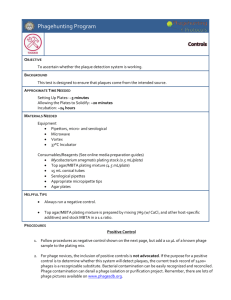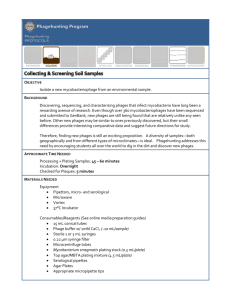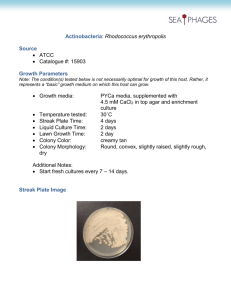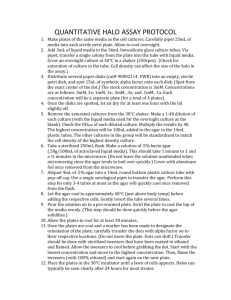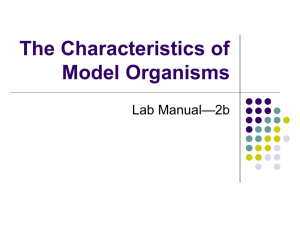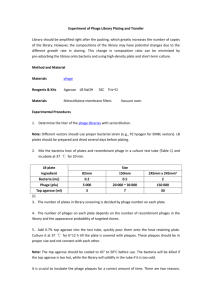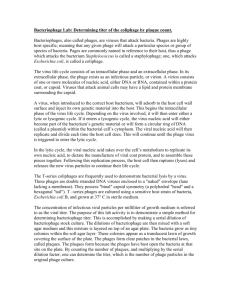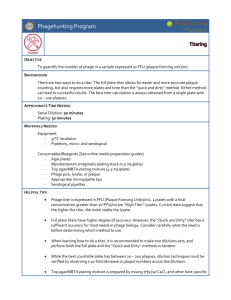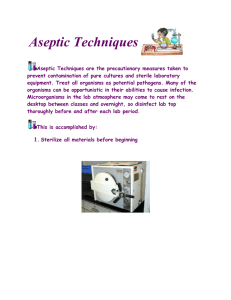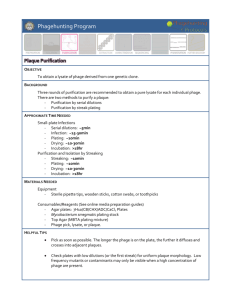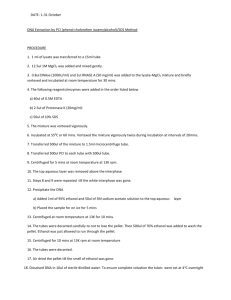Collecting & Screening Soil Samples
advertisement
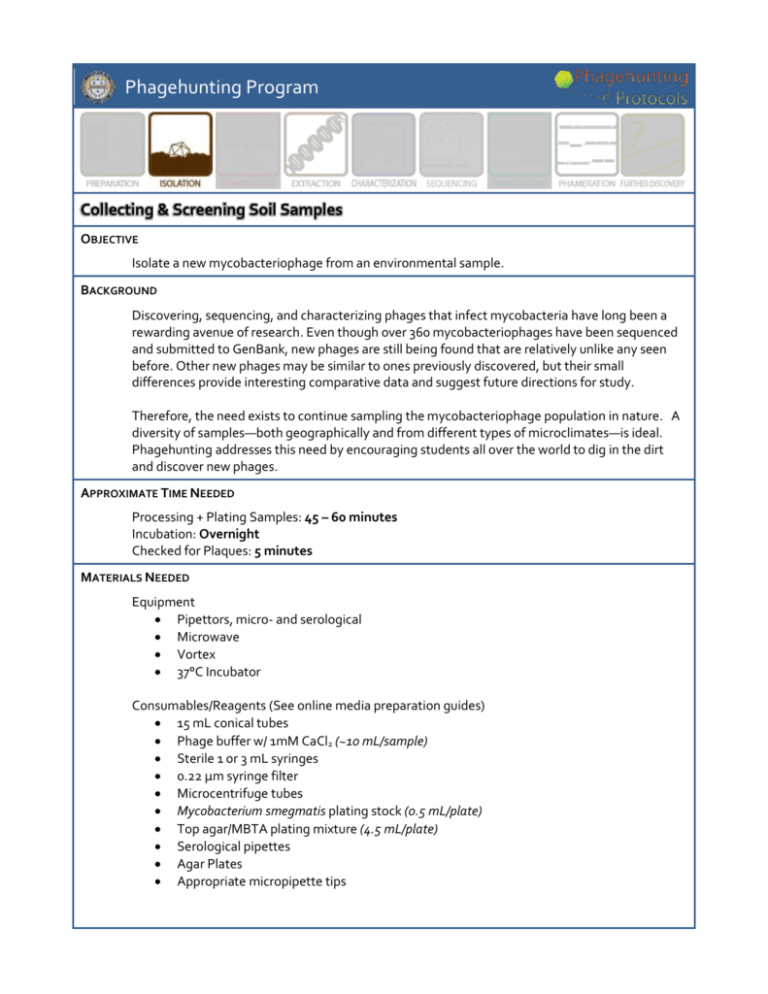
Phagehunting Program Collecting & Screening Soil Samples OBJECTIVE Isolate a new mycobacteriophage from an environmental sample. BACKGROUND Discovering, sequencing, and characterizing phages that infect mycobacteria have long been a rewarding avenue of research. Even though over 360 mycobacteriophages have been sequenced and submitted to GenBank, new phages are still being found that are relatively unlike any seen before. Other new phages may be similar to ones previously discovered, but their small differences provide interesting comparative data and suggest future directions for study. Therefore, the need exists to continue sampling the mycobacteriophage population in nature. A diversity of samples—both geographically and from different types of microclimates—is ideal. Phagehunting addresses this need by encouraging students all over the world to dig in the dirt and discover new phages. APPROXIMATE TIME NEEDED Processing + Plating Samples: 45 – 60 minutes Incubation: Overnight Checked for Plaques: 5 minutes MATERIALS NEEDED Equipment Pipettors, micro- and serological Microwave Vortex 37°C Incubator Consumables/Reagents (See online media preparation guides) 15 mL conical tubes Phage buffer w/ 1mM CaCl2 (~10 mL/sample) Sterile 1 or 3 mL syringes 0.22 μm syringe filter Microcentrifuge tubes Mycobacterium smegmatis plating stock (0.5 mL/plate) Top agar/MBTA plating mixture (4.5 mL/plate) Serological pipettes Agar Plates Appropriate micropipette tips HELPFUL TIPS Soil gathering can take place days ahead of the sample processing. However, it is preferable to not let the sample dry out. In general, only about 1 in every 30 samples screened will yield a phage that infects Mycobacterium smegmatis. There are some general guidelines that may be followed to increase these odds. Mycobacteriophages are likely to be found where mycobacteria are found. Thus, soil that is not conducive to bacterial growth (e.g., cold, dry, acidic) is less likely to yield a phage. Conversely, areas where high bacterial growth might be (damp, aerated, warm, decaying soil) are good places to collect samples. If possible, record the GPS location where the environmental samples was collected. If the top agar begins to solidify or become chunky before the sample is plated, it is most likely the result of the top agar being too cool. If that is the case, bring the top agar back to boiling to ensure that the entire bottle is re-melted. When re-melting, the calcium may precipitate out of solution – simply mix to re-suspend. Chunky agar makes plaque identification difficult. (See the last hint!) It is generally a good idea to run a negative control alongside the samples being processed. This will give an indication of whether a good bacterial lawn can be obtained in the first place, and what that lawn should look like in the absence of any phage. An excellent approach to a negative control is to plate the smeg and top agar. Allow the plate to solidify, and then spot with 10 μL of buffer. While bacterial contamination is certainly undesirable, phage contamination are much more detrimental. By separating the buffer from the smeg in the negative control, the source of contamination will be identified much easier (See TOOLBOX: Controls for details). Label plates and tubes in advance so not to lose track of samples. It is important to document the source of the sample and catalogue it throughout the process of isolation, amplification, and sequencing. PROCEDURES Day One 1. Place ~5 mL of environmental sample in a 15 mL conical tube. Do not pack samples tightly, as this will interfere with mixing. 2. Add 5 – 10 mL of phage buffer to each sample. For liquid samples, simply proceed to step 5. 3. Cap tube and vortex or shake vigorously to mix well. 4. Allow sample to rest for ~10 minutes until particulate matter has mostly settled. 5. Using a sterile syringe, remove about 1 mL of liquid from the top of the tube (see Figure 1A). Avoid the solid material at the bottom of the tube to prevent the filter from being clogged. 6. Attach a syringe filter (0.22 μm) to the end of the syringe, making sure to screw it tightly into place (see Figure 1B). Figure 1: From Soil to Plate 7. Expunge the contents of the syringe into a clearly labeled microcentrifuge tube. Note the change in the sample after it passes through the filter. Note: If plates and agar are not prepared, samples at this stage can be kept at 4°C for up to 1 week. 8. Add 0.5 mL (500 μL) of the M. smegmatis culture to a sterile 15 mL conical tube. 9. Using a micropipettor, add 50 μL of the filtered environmental sample to the tube containing M. smegmatis (see Figure 1C). Vortex. Samples should be allowed to sit for around 15 minutes to allow any phages that are present to adsorb to the bacteria. Prepare the top agar in the mean time. 10. Prepare the top agar: a. Heat the MBTA in a microwave, interrupting and shaking periodically, until it bubbles and no visible solid chunks remain. b. Add an equal volume of room temperature 7H9 w/ + 2 mM CaCl2 (and any other hostspecific additives) to the hot MBTA. Mix until well combined. This will dilute the CaCl2 to an appropriate final concentration (1 mM) as well as cool the MBTA to a usable temperature. Use the top agar immediately to prevent chunking. 11. While the top agar is still very warm, use a serological pipette to add ~4.5 mL of it to the tube containing M. smegmatis. 12. Pour the warm sample onto a labeled agar plate (see Figure 1D). Immediately, but gently, swirl the plate in a circular pattern to spread the agar evenly across the surface of the plate. Allow the plates to sit still after swirling until the agar has solidified (generally ~15 minutes). 13. Once the top agar has completely solidified, move plate(s) to a 37°C incubator and invert. Leave plates at 37°C for 18 – 48 hours. Day Two 1. Remove plates from incubator, and check for plaques. Real plaques will generally be circular areas of clearing in the bacterial lawn where phages have killed the bacteria. The best way to look for plaques is to remove the lid from a plate, allow any condensation to drip onto a paper towel, and then hold the plate up to a light source. Light will show through more clearly where the bacterial lawn has been cleared. See Figure 2 for examples of plaques. 2. If plaques are found, record any observations. a. Include number of plaques, number of types of plaques, how many of each, size of plaque diameter (in mm), whether they are clear or turbid, and any other interesting features observed in the plaques (edges, halos, comets, etc.) b. Photograph the plate containing plaques with the best camera available (See TOOLBOX: Taking Plaque Pictures / TOOLBOX: Using a Gel-Doc Camera to Take Plaque Pictures). c. Pick any putative plaques observed (See TOOLBOX: Picking a Plaque), but also reincubate the plate to observe changes in the plaque morphology over time. 3. If no plaques are observed, leave the plates in the incubator for another day and check again. If no plaques are found after 48 hours, it’s back to digging in the dirt. The extended incubation time is needed because of smeg’s doubling time. As long as the bacteria are still dividing, there is a chance that a new plaque will “blossom.” 4. After any putative plaques have been identified, the next step is to verify that they’re really caused by a phage, as popped air bubbles can give the appearance of being plaques. No plaque should ever be disregarded as an air bubble! Figure 2: Examples of different types/sizes of plaques
